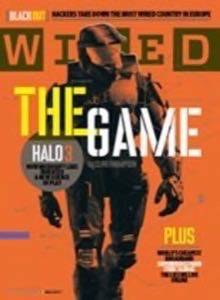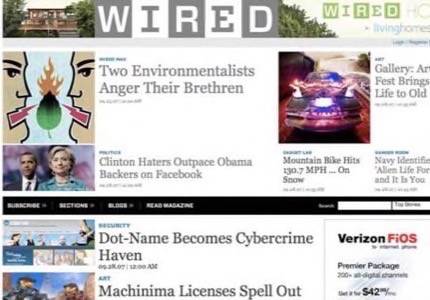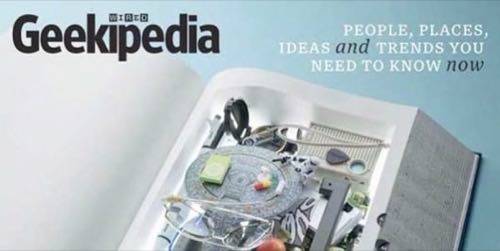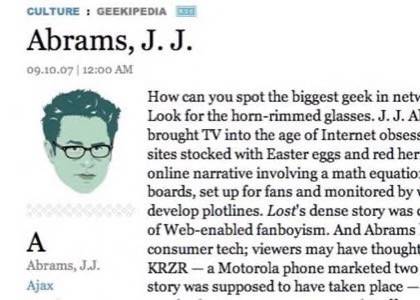Wired magazine has been telling us what’s hip
and cool in technology since the birth of the Web. In this post, we look at the elements that make up Wired – and how it continues to evolve as both a print and online publication.

Led by its current editor in chief, Chris Anderson (since 2001), Wired has always stayed true
to its original style and format. From jargon, to gadgets, to tech breakthroughs and the people behind the technology, Wired
has remained on cutting edge and, at times, defined it. Also over the past decade and more, Wired and other Conde Nast publications have adapted well
to the print-online duality. Today the company maintains a print edition, an online edition, a rich set of
logs and, recently launched, Geekipedia. The print edition brings subscription revenue
as well as advertising dollars. The online edition is free, supported only by advertising.
Wired, The Print Edition
The print edition of Wired costs $10 a year. Considering that a pack of cigarettes in New York costs $9, it seems ridiculously low
(and much healthier than smoking!). But actually, in our day and age people do not want to pay for information.
Magazines and traditional media are rapidly giving way to free online content. Yet, Wired is worth paying for – because in print, its design and other attributes are are gorgeous.

A few years ago, the editor of MIT Technology Review wrote that the format of ‘the magazine’ is changing. To address the
increasing shift into online information consumption, MIT Technology Review announced it would become thinner, have shorter stories and will
feature more photo essays. The simple insight here is that to keep its subscribers, the MIT magazine needed to do something in print that
wouldn’t be easy to replicate online. But Wired has had this formula all along.
Made from the thick paper, with bright, loud colors, generous pictures and elegant sidebars, Wired is a pleasure to hold and
to flip through. Most of the stories are bite sized, designed to accommodate increasingly ADD readers. The middle of the magazine
features gadget and game reviews, aiming to please different kinds of geek. And the features are always thoroughly researched,
informative, and focused on the latest technology and people.
How Does the Print Edition Make Money?
In 2005 Wired won an excellence award and increased its
subscription base to 1 million. At a rate of $10 per subscription, that is $10M right there. In addition, Wired undoubtedly makes
good money from advertising. And like the rest of the magazine, the ads are gorgeous. Just flipping through the last edition,
I saw Infinity, Sprint, Epson, Dillards, TurboChef, Rolex, Pioneer, BlackBerry, Claiborne, Sharp and, my personal favorite,
the Patron Tequila – all within the first few pages. These kinds of advertisers are indicative of the success of the magazine
and the kind of audience it is reaching.
To give you an idea of the current rates, a full page ad in PC Magazine goes for $65K. Taking a ballpark of $50K and assuming that only 20% of the 200 pages of Wired are ads, it comes to $2M per issue – or $24M annually.
But this number is likely to be much bigger for Wired.
Wired.com – Wired Reloaded
The online edition has a different feel. It does not have the ‘loud’ look of the print version. The website is clean and informative.
After staring at it for 10 seconds, you realize that the print and online do not compete – but
rather they complement each other. The online version gives you the dry story, without fun and playfulness of the print version.
The website offers much more than just the magazine content re-purposed. It features a mix of blogs, magazine features and sections focused on a topic.
The sections actually recycle content from the magazine and their blogs, creating another way to get to the same information.

The site has also embraced and integrated the latest social software features. On the bottom of an article, readers can add to del.icio.us or digg – but most notably to reddit, which is owned by Conde Nast. In addition, there is a sort of
‘digg clone’ built in, which lets readers vote on each others comments. This particular feature does not seem
very engaging, as the users must be logged in to be able to vote.
Wired Blogs and Geekipedia
The 12 blogs offered by Wired online are on a range of topics; from Compiler,
which focuses on software, technology and tech news, to Listening Post, which covers
digital music, to Wired Science, which blogs about science news. These blogs
are of the highest quality, update frequently and push out a wealth of information. Subscribing to just these blogs could
easily fill one’s daily reading appetite.

Geekipedia is the latest spin on pop culture launched by Wired. With the aim to build a web destination,
Wired shrewdly gave away a print edition of Geekipedia for free. The 149 entries so far focus on people, places, ideas and trends that Wired editors
think everyone ought to know. Each entry is a bite size paragraph, designed to inform – but mostly to spark interest and
prompt further exploration.

In this format, it is difficult to see this as a competitor to Wikipedia – and it is not. But Wired is making some interesting moves with this publication.
The Geekipedia web pages invite users to suggest new entries, as well as vote on the current ones. We will have to see how this experiment goes – so far, the site does not have the level of participation that we find on active social sites.
How Does the Online Edition Make Money?
Among the banner advertisers on Wired.com, we spotted Intel, Adobe, Sony, Yamaha and BASF. The ads seem to be targeted at a much more
technical crowd than in the paper magazine. It is also interesting that most of the banner ads are not contextual and there isn’t a great variety. In addition to
the banner ads, on the very bottom of the pages there are Google ads – which seem quite out of place there.
Another interesting thing is that Conde Nast heavily cross-promotes its other properties on Wired.com. Instead of ads,
there are promos for their other publications – e.g. enticing readers to subscribe to the print version of Wired. This suggests that
the ad space online, at least for now, is worth less than subscriptions and ads in the magazine.
Conclusion
Wired is still cool, alive and very much kicking. Its print edition appears to be doing very well. Its online presence is
complementary and cross-promotes other Conde Nast publications. It also features 12 great blogs. With the recent launch of
Geekipedia, Wired made an interesting move – possibly an attempt to grow a niche community site. It seems like a great idea; because the mix between the Wikipedia style, a more narrow focus, Digg-like voting and bite size content,
might be just want people are looking for.
Are you a fan of Wired? Why or why not? Do you enjoy the print magazine or online edition more? Please share your thoughts with us.
Note: Images in this post are from Wired Magazine.





















